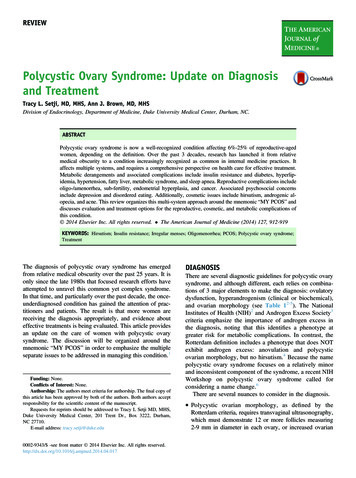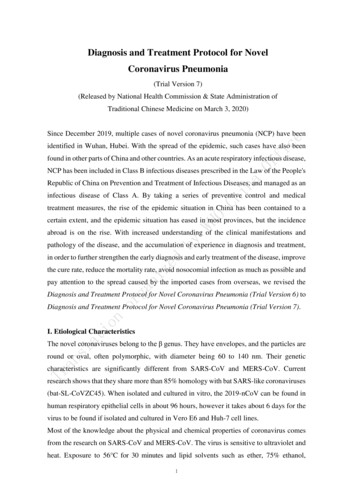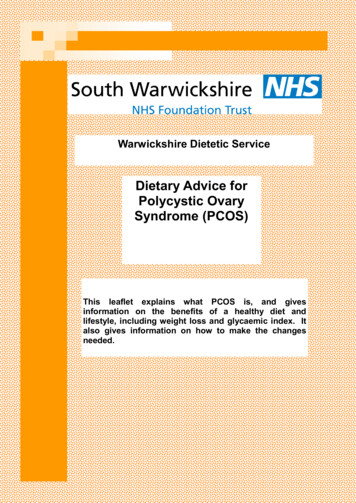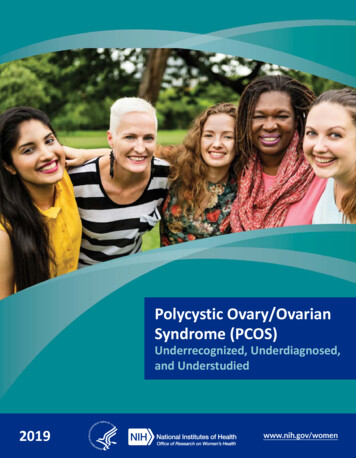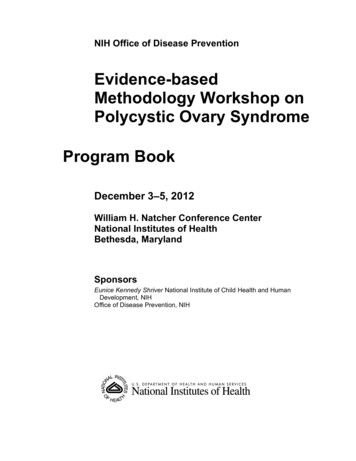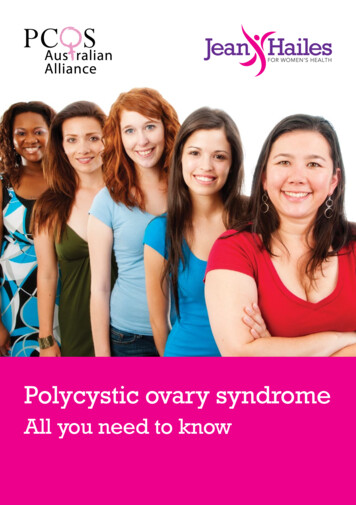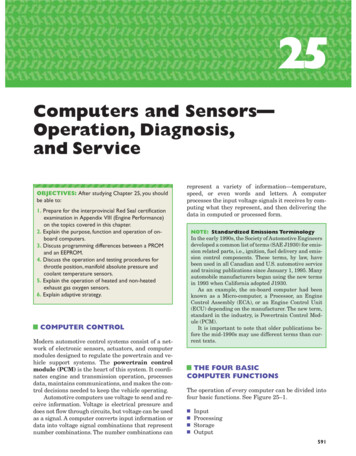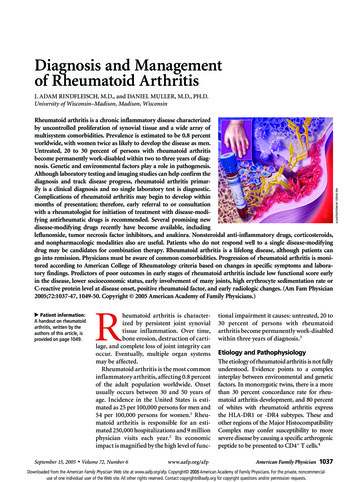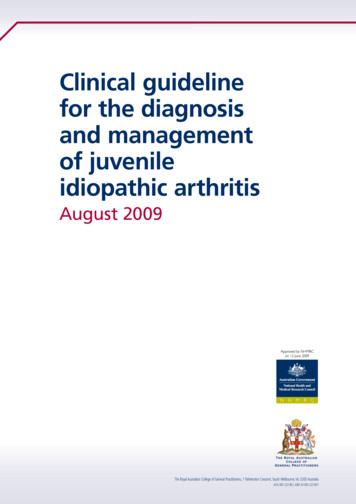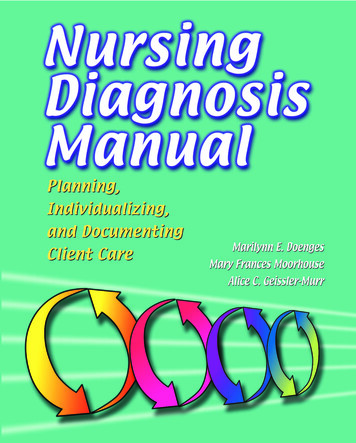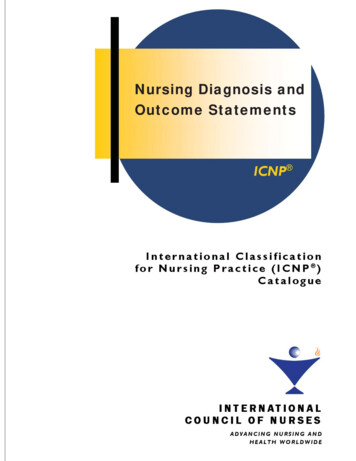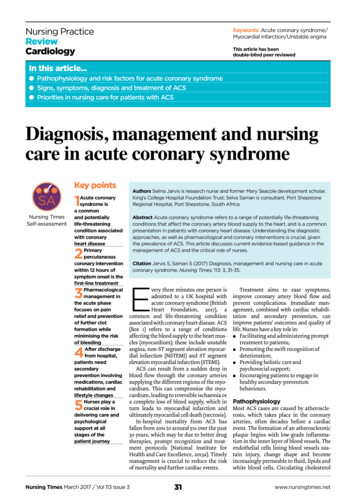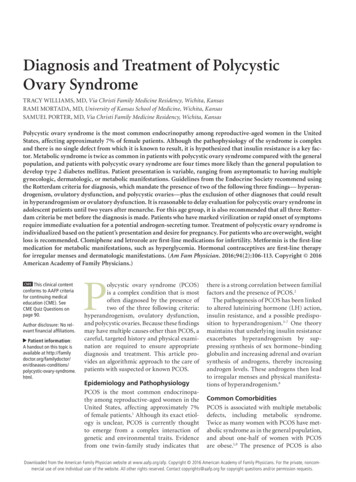
Transcription
Diagnosis and Treatment of PolycysticOvary SyndromeTRACY WILLIAMS, MD, Via Christi Family Medicine Residency, Wichita, KansasRAMI MORTADA, MD, University of Kansas School of Medicine, Wichita, KansasSAMUEL PORTER, MD, Via Christi Family Medicine Residency, Wichita, KansasPolycystic ovary syndrome is the most common endocrinopathy among reproductive-aged women in the UnitedStates, affecting approximately 7% of female patients. Although the pathophysiology of the syndrome is complexand there is no single defect from which it is known to result, it is hypothesized that insulin resistance is a key factor. Metabolic syndrome is twice as common in patients with polycystic ovary syndrome compared with the generalpopulation, and patients with polycystic ovary syndrome are four times more likely than the general population todevelop type 2 diabetes mellitus. Patient presentation is variable, ranging from asymptomatic to having multiplegynecologic, dermatologic, or metabolic manifestations. Guidelines from the Endocrine Society recommend usingthe Rotterdam criteria for diagnosis, which mandate the presence of two of the following three findings— hyperandrogenism, ovulatory dysfunction, and polycystic ovaries—plus the exclusion of other diagnoses that could resultin hyperandrogenism or ovulatory dysfunction. It is reasonable to delay evaluation for polycystic ovary syndrome inadolescent patients until two years after menarche. For this age group, it is also recommended that all three Rotterdam criteria be met before the diagnosis is made. Patients who have marked virilization or rapid onset of symptomsrequire immediate evaluation for a potential androgen-secreting tumor. Treatment of polycystic ovary syndrome isindividualized based on the patient’s presentation and desire for pregnancy. For patients who are overweight, weightloss is recommended. Clomiphene and letrozole are first-line medications for infertility. Metformin is the first-linemedication for metabolic manifestations, such as hyperglycemia. Hormonal contraceptives are first-line therapyfor irregular menses and dermatologic manifestations. (Am Fam Physician. 2016;94(2):106-113. Copyright 2016American Academy of Family Physicians.)CME This clinical contentconforms to AAFP criteriafor continuing medicaleducation (CME). SeeCME Quiz Questions onpage 90.Author disclosure: No relevant financial affiliations. Patient information:A handout on this topic isavailable at http://family doctor.org/family drome.html.Polycystic ovary syndrome (PCOS)is a complex condition that is mostoften diagnosed by the presence oftwo of the three following criteria:hyperandrogenism, ovulatory dysfunction,and polycystic ovaries. Because these findingsmay have multiple causes other than PCOS, acareful, targeted history and physical examination are required to ensure appropriatediagnosis and treatment. This article provides an algorithmic approach to the care ofpatients with suspected or known PCOS.Epidemiology and PathophysiologyPCOS is the most common endocrinopathy among reproductive-aged women in theUnited States, affecting approximately 7%of female patients.1 Although its exact etiology is unclear, PCOS is currently thoughtto emerge from a complex interaction ofgenetic and environmental traits. Evidencefrom one twin-family study indicates thatthere is a strong correlation between familialfactors and the presence of PCOS.2The pathogenesis of PCOS has been linkedto altered luteinizing hormone (LH) action,insulin resistance, and a possible predisposition to hyperandrogenism.3-7 One theorymaintains that underlying insulin resistanceexacerbates hyperandrogenism by suppressing synthesis of sex hormone–bindingglobulin and increasing adrenal and ovariansynthesis of androgens, thereby increasingandrogen levels. These androgens then leadto irregular menses and physical manifestations of hyperandrogenism.8Common ComorbiditiesPCOS is associated with multiple metabolicdefects, including metabolic syndrome.Twice as many women with PCOS have metabolic syndrome as in the general population,and about one-half of women with PCOSare obese.1,9 The presence of PCOS is also106AmericanFamilyPhysicianwww.aafp.org/afp94, Number2 private,July 15,2016Downloadedfrom theAmericanFamily Physician website at www.aafp.org/afp.Copyright 2016 American Academy ofVolumeFamily Physicians.For thenoncom mercial use of one individual user of the website. All other rights reserved. Contact copyrights@aafp.org for copyright questions and/or permission requests.
Polycystic Ovary SyndromeTable 1. Criteria for Diagnosis of PCOSClinical findingNational Institutes of Healthcriteria, 1990 (must have bothof the findings marked below)Rotterdam criteria, 2003(must have any two of thefindings marked below)Androgen Excess and PCOSSociety, 2009 (must have Aplus either B or c ovariesPCOS polycystic ovary syndrome.*—Clinical or biochemical evidence of excess androgen.Information from reference 19.associated with a fourfold increase in the risk of type 2diabetes mellitus.10 There is an increased prevalence ofnonalcoholic fatty liver disease,11,12 sleep apnea,13 and dyslipidemia14 in patients with PCOS, even when controlledfor body mass index. Rates of cardiovascular disease arehigher in patients with PCOS, but increased cardiovascular mortality has not been consistently demonstrated.15,16Finally, there is evidence to suggest an increased risk ofmood disorders among patients with PCOS.17,18Given the conditions associated with PCOS, the Endocrine Society, the Androgen Excess and PCOS Society, andthe American College of Obstetricians and Gynecologistsrecommend that clinicians evaluate patients’ blood pressure at every visit and lipid levels at the time of diagnosis, and screen for type 2 diabetes with a two-hour oralglucose tolerance test regardless of a patient’s body massindex. Patients should have repeat diabetes screening everythree to five years, or more often if other indications forscreening are present.19-21 The Endocrine Society furtherrecommends depression screening, as well as screening forsymptoms of obstructive sleep apnea in overweight andobese patients with PCOS.19 However, routine screeningfor nonalcoholic fatty liver disease or endometrial cancer(using ultrasonography) is not recommended.19Clinical PresentationThe clinical presentation of PCOS is variable. Patientsmay be asymptomatic or they may have multiple gynecologic, dermatologic, or metabolic manifestations.Patients with PCOS most commonly present with signsof hyperandrogenism and a constellation of oligomenorrhea, amenorrhea, or infertility.19,22 Workup for PCOSis sometimes prompted by an incidental finding of multiple ovarian cysts after ultrasonography.Diagnostic WorkupThe diagnostic workup should begin with a thoroughhistory and physical examination. Clinicians shouldfocus on the patient’s menstrual history, any fluctuations in the patient’s weight and their impact on PCOSJuly 15, 2016 Volume 94, Number 2symptoms, and cutaneous findings (e.g., terminal hair,acne, alopecia, acanthosis nigricans, skin tags).19 Patientsshould also be asked about factors related to commoncomorbidities of PCOS.The Endocrine Society advises clinicians to diagnosePCOS using the 2003 Rotterdam criteria (Table 119),although recommendations differ across guidelines.23According to the Rotterdam criteria, diagnosis requiresthe presence of at least two of the following three findings: hyperandrogenism, ovulatory dysfunction, andpolycystic ovaries.Diagnosis can generally be accomplished with a careful history, physical examination, and basic laboratorytesting, without the need for ultrasonography or otherimaging. Hyperandrogenism can be diagnosed clinicallyby the presence of excessive acne, androgenic alopecia, orhirsutism (terminal hair in a male-pattern distribution);or chemically, by elevated serum levels of total, bioavailable, or free testosterone or dehydroepiandrosterone sulfate.23 Measurement of androgen levels is helpful in therare occasion that an androgen-secreting tumor is suspected (e.g., when a patient has marked virilization orrapid onset of symptoms associated with PCOS).Ovulatory dysfunction refers to oligomenorrhea(cycles more than 35 days apart but less than six monthsapart) or amenorrhea (absence of menstruation for six to12 months after a cyclic pattern has been established).24A polycystic ovary is defined as an ovary containing 12or more follicles (or 25 or more follicles using new ultrasound technology) measuring 2 to 9 mm in diameteror an ovary that has a volume of greater than 10 mL onultrasonography. A single ovary meeting either or bothof these definitions is sufficient for diagnosis of polycystic ovaries.23,25 However, ultrasonography of the ovariesis unnecessary unless imaging is needed to rule out atumor or the patient has met only one of the other Rotterdam criteria for PCOS.19,26 Polycystic ovaries meetingthe above parameters can be found in as many as 62% ofpatients with normal ovulation, with prevalence declining as patients increase in age.27www.aafp.org/afp American Family Physician 107
Polycystic Ovary SyndromeDiagnosis of Polycystic Ovary SyndromePatient meets clinical criteria for PCOS*?NoYesConsider serum androgen test and/or ovarian ultra sonography if abnormal result would lead to diagnosisIf findings meet criteria for PCOSPerform pregnancy test and measure serum TSH, prolactin, and 17-hydroxyprogesterone† to rule outpregnancy, thyroid dysfunction, hyperprolactinemia, and nonclassical congenital adrenal hyperplasiaNormal findingsLow body weight,eating disorder, orexcessive exercise?Hot flashesand urogenitalsymptoms?Severe virilization (change invoice, clitoromegaly, rapid onset)?Buffalo hump,purple striae,hypertension?Change in hat orglove size, protrudingjaw, impaired vision?Measure serum LH, FSH,and estradiol to rule outhypothalamic amenorrheaMeasure serum FSHand estradiol to ruleout primary ovarianinsufficiencyMeasure total testosterone†and DHEA-S,† then performultrasonography of ovaries andCT or MRI of adrenals to rule outan androgen-secreting tumorMeasure salivary orurinary cortisol levels orperform dexamethasonesuppression test to ruleout Cushing syndromeMeasure insulinlikegrowth factor 1 torule out acromegalyNormalNormalNormalNormalNormalDiagnosis confirmedProceed with screening: Check blood pressure and perform lipid paneland two-hour OGTT, evaluate for signs and symptoms of obstructivesleep apnea in overweight patients and for depression‡*—Patient has both hyperandrogenism (excessive acne, androgenic alopecia, or hirsutism) and ovulatory dysfunction.†—Measurement to be taken in the morning, preferably during the follicular phase.‡—Screen for hypertension, type 2 diabetes mellitus, dyslipidemia, depression, and obstructive sleep apnea, given their association with PCOS.Figure 1. Diagnosis of polycystic ovary syndrome. (CT computed tomography; DHEA-S dehydroepiandrosteronesulfate; FSH follicle-stimulating hormone; LH luteinizing hormone; MRI magnetic resonance imaging; OGTT oralglucose tolerance test; PCOS polycystic ovary syndrome; TSH thyroid-stimulating hormone.)Information from reference 19.The goal of further evaluation of suspected PCOS istwofold: to exclude other treatable conditions that canmimic PCOS and to detect and treat long-term metaboliccomplications. Anovulation is common after menarche,so it is reasonable to delay workup for PCOS in adolescents until they have been oligomenorrheic for at least twoyears.28 If an adolescent is evaluated for PCOS, it has beensuggested that she meet all three of the Rotterdam criteriabefore being diagnosed with the condition28 (Table 119).The differential diagnosis of PCOS is broad andincludes both endocrinologic and malignant etiologies.108 American Family PhysicianFigure 119 provides an algorithm for the workup of selectpresentations. For any woman with suspected PCOS, theEndocrine Society recommends excluding pregnancy,thyroid dysfunction, hyperprolactinemia, and nonclassical congenital adrenal hyperplasia.19 Depending onpresentation, conditions such as hypothalamic amenorrhea and primary ovarian insufficiency should also beexcluded. In women with rapid symptom onset or significant virilization, such as deepening voice or clitoromegaly, an androgen-secreting tumor should be ruledout. Finally, Cushing syndrome or acromegaly should bewww.aafp.org/afpVolume 94, Number 2 July 15, 2016
Polycystic Ovary SyndromeManagement of Polycystic Ovary SyndromePregnancy or ovulation induction desired?YesAnovulationor infertilityNoFirst line: Clomiphene orletrozole (Femara)Anovulationor menstrualirregularitiesSecond line: MetforminFirst line: Hormonal contraception,including the levonorgestrel-releasingintrauterine system (Mirena)Second line: MetforminInsulin resistanceFirst line: MetforminInsulin resistanceObesityFirst line: Lifestyle modificationObesityHirsutismFirst line: Electrolysis and lightbased therapies (effective formild cases)HirsutismFirst line: MetforminFirst line: Lifestyle modificationFirst line: Hormonal contraception with orwithout antiandrogen therapySecond line: Spironolactone monotherapy,*electrolysis, light-based therapies,eflornithine (Vaniqa), finasteride (Proscar)Third line: MetforminAcneTopical creams (e.g., antibiotic,benzoyl peroxide)AcneFirst line: Hormonal contraception; topicalcreams, including benzoyl peroxide,tretinoin (Retin-A), adapalene (Differin),or antibiotic creamSecond line: Spironalactone*—Antiandrogens such as spironolactone must be prescribed with contraception because they can cause pseudohermaphroditism in a male fetus.Figure 2. Management of polycystic ovary syndrome. Treatment options vary depending on patient’s desire for contraception. Lifestyle modification is a central part of treatment for all manifestations of polycystic ovary syndrome.Information from references 19, and 29 through 35.excluded in patients with physical findings that suggesteither condition.19 There is no need to order laboratorytesting for these conditions if the patient does not havesuggestive physical findings.Other tests that may be helpful but are not necessaryfor diagnosis include measurement of LH and folliclestimulating hormone (FSH) levels to determine a serumratio of LH/FSH. A ratio greater than 2 generally indicates PCOS, but there are no exact cutoff values becausemany different assays are used.26 The FSH level is morehelpful in ruling out ovarian failure.26TreatmentPCOS is a multifaceted syndrome that affects multipleorgan systems with significant metabolic and reproductive manifestations. Treatment should be individualizedbased on the patient’s presentation and desire for pregnancy (Figure 219,29-35). Devices and medications usedto treat manifestations of PCOS, and their associatedadverse effects, are described in Table 2.19,29-33,36A team approach involving care by primary care andsubspecialist physicians can be helpful to address themultiple manifestations of the syndrome. Goals fortreatment (e.g., treating infertility; regulating menses for endometrial protection; controlling hyperandrogenic features, including hirsutism and acne) mustJuly 15, 2016 Volume 94, Number 2account for the patient’s preferences because therapyselection may otherwise conflict with outcomes that thepatient considers important. Metabolic complicationsshould be addressed in every patient via a blood pressure evaluation, a lipid panel, and a two-hour oral glucose tolerance test. Patients who are overweight shouldbe evaluated for signs and symptoms of obstructivesleep apnea. All patients should be screened for depression (Figure 119).ANOVULATION AND INFERTILITYLifestyle modification and weight reduction reduce insulin resistance and can significantly improve ovulation.Therefore, lifestyle modification is first-line therapy forwomen who are overweight.37 A calorie-restricted diet isrecommended for all patients with PCOS who are over-WHAT IS NEW ON THIS TOPIC: POLYCYSTIC OVARYSYNDROMERecent studies suggest that letrozole (Femara) is associatedwith higher live-birth and ovulation rates compared withclomiphene in patients with polycystic ovary syndrome.A 2012 Cochrane review concluded that metformin does notimprove fertility in patients with polycystic ovary syndrome.www.aafp.org/afp American Family Physician 109
Polycystic Ovary Syndromeweight. Weight loss has been shown to have a positiveeffect on fertility and metabolic profile.19,30 The Endocrine Society recommends clomiphene or letrozole(Femara) for ovulation induction. Recent studies suggest that letrozole is associated with higher live-birthrates and ovulation rates compared with clomiphene inpatients with PCOS.29 The impact of metformin on fertility is controversial; although it was once believed toimprove infertility, a 2012 Cochrane review concludedthat it does not.38Table 2. Treatments for Polycystic Ovary SyndromeMedication or deviceDescriptionManifestations treatedFDA pregnancycategoryClomiphene†Ovulation induction agent, selectiveestrogen receptor modulatorInfertility (first-line therapy)19XEflornithine (Vaniqa)‡§Inhibits hair growthMild hirsutism (second-line therapy) 33CFinasteride (Proscar)‡5-alpha-reductase inhibitorHirsutism (weak recommendation because ofinconsistent study results) 32XFlutamide‡Nonsteroidal antiandrogen usedmostly for prostate cancerHirsutism (safe and effective according to low- tovery low-quality evidence) 32DHormonal contraceptives(e.g., pill, patch,vaginal ring)‡ See article for detailsMenstrual irregularities, hirsutism, acne (first-linetherapy)19,30,32XLetrozole (Femara)‡Nonsteroidal competitive inhibitorof aromatase; inhibits conversionof adrenal androgensInfertility (first-line therapy)19,29CLevonorgestrel-releasingintrauterine system(Mirena)‡Intrauterine deviceEndometrial hyperplasiaXMetformin‡Insulin-sensitizing agentAbnormal uterine bleeding (FDA approved) 31Insulin resistance (first-line therapy)BMenstrual irregularities (second-line therapy addedto hormonal contraceptives)Hirsutism (third-line therapy added to hormonalcontraceptives and timineral ocorticoidHirsutism (second-line therapy added after 6 monthsof oral contraceptive therapy if not improved) 32,33CAcne (second-line therapy)NOTE:Thiazolidinediones have been omitted from the table because the Endocrine Society has determined that their risk-benefit ratio is unfavorable.FDA U.S. Food and Drug Administration; MI myocardial infarction; PCOS polycystic ovary syndrome.*—Estimated retail price of one month’s treatment (unless otherwise noted) based on information obtained at www.goodrx.com and www.lowestmed.com (accessed May 24, 2015).†—FDA approved for female infertility caused by PCOS.‡—Not FDA approved for treatment of manifestations of PCOS.§—Not studied specifically in women with PCOS; therefore, effectiveness is unknown. —Based on mostly anecdotal evidence.Adapted with permission from Radosh L. Drug treatments for polycystic ovary syndrome. Am Fam Physician. 2009;79(8):672-673, with additionalinformation from references 19, and 29 through 33.110 American Family Physicianwww.aafp.org/afpVolume 94, Number 2 July 15, 2016
Polycystic Ovary SyndromeMENSTRUAL IRREGULARITYand hyperandrogenism manifesting as acne or hirsutism.19,30 Small studies have shown that metformin canrestore regular menses in up to 50% to 70% of womenwith PCOS,39,40 but oral contraceptives have been shownto be superior to metformin for regulating menses andlowering androgen levels.30 There are nostudies demonstrating superiority of oneoral contraceptive over another in treatingPCOS. Prevention of endometrial hyperplasia from chronic anovulation may be accomCost*plished either by progesterone derivatives,progestin-containing oral contraceptives, 15 for 100 mg dailyfor 5 daysor the levonorgestrel-releasing intrauterinesystem (Mirena).31,41 Patient comfort andpreference should also be taken into account 78 (brand) for1 30-g tubewhen treating irregular menses.In a patient not seeking pregnancy, the Endocrine Society recommends hormonal contraception (i.e., oralcontraceptive, dermal patch, or vaginal ring) as theinitial medication for treatment of irregular mensesMain adverse effectsTypical dosageMultiple pregnancy or ovarianhyper stimulation, thrombo embolism, visual disturbances50 to 100 mg dailyMild skin irritation13.9% cream appliedto affected areatwice dailyHypersensitivity reaction,decreased libido5 mg dailyLiver toxicity, thrombo cytopenia,leukopenia, hot flashes250 mg once ortwice daily32 32 for 250 mg dailyNausea, headache, spotting,throm bophlebitis, deepvenous thrombosisVariesVariesOsteoporosis, thrombo embolism, MI, hot flashes,arthralgias2.5 to 7.5 mg dailyfor 5 days 8 (generic) and 128(brand) for 2.5 mgdaily for 5 daysAmenorrhea, nausea, vomiting;rare complications include thedevice becoming embeddedin the myometrium anduterine perforation5 years 815 (not includingcost of placement)Gastrointestinal upset,lactic acidosis, increase inhomocysteine levels1,500 to 2,250 mgdaily 4 for 1,000 mgtwice dailyHyperkalemia, nausea, breasttenderness50 mg daily to 100to 200 mg daily 10 (generic) and 273 (brand) 15 for 100 mg dailyHIRSUTISMHirsutism is a bothersome hyperandrogenicmanifestation of PCOS that may require atleast six months of treatment before improvement begins. According to a 2015 Cochranereview, the most effective first-line therapyfor mild hirsutism is oral contraceptives.32Spironolactone, 100 mg daily, and flutamide,250 mg twice daily, are safe for patient use,but the evidence for their effectiveness isminimal.32 Other therapies include eflornithine (Vaniqa), electrolysis, or light-basedtherapies such as lasers and intense pulsedlight. Any of these can be used as monotherapy in mild cases or as adjunctive therapy inmore severe cases.33ACNEAcne is common in the general population and in patients with PCOS. Hormonalcontraceptives are first-line medications fortreating acne associated with PCOS and canbe used in conjunction with standard topical acne therapy (e.g., retinoids, antibiotics,benzoyl peroxide) or as monotherapy.19,34Antiandrogens, spironolactone being themost common, can be added as second-linemedications.19,34Areas for Future ResearchMore research is needed to clarify the complex pathophysiology of PCOS. No singletest is currently available for its diagnosis.Additionally, once diagnosis is established,July 15, 2016 Volume 94, Number 2www.aafp.org/afp American Family Physician 111
Polycystic Ovary SyndromeSORT: KEY RECOMMENDATIONS FOR PRACTICEEvidenceratingReferencesAll women diagnosed with PCOS should be screened for metabolic abnormalities (e.g., type 2 diabetesmellitus, dyslipidemia, hypertension), regardless of body mass index.C19-21All women with suspected PCOS should be screened for thyroid disease, hyperprolactinemia, and nonclassicalcongenital adrenal hyperplasia.C19A calorie-restricted diet is recommended for all patients with PCOS who are overweight. Weight loss has beenshown to have a positive effect on fertility and metabolic profile.A19, 37Hormonal contraception (e.g., oral contraceptives) should be used as the initial treatment for menstrual cycleirregularity, hirsutism, and acne in patients with PCOS who are not actively trying to get pregnant.A19, 30Clinical recommendationPCOS polycystic ovary syndrome.A consistent, good-quality patient-oriented evidence; B inconsistent or limited-quality patient-oriented evidence; C consensus, disease-orientedevidence, usual practice, expert opinion, or case series. For information about the SORT evidence rating system, go to http://www.aafp.org/afpsort.the options for treatment are of limited number andeffectiveness because they target only the symptoms ofPCOS. Finally, patients with PCOS have higher rates ofmetabolic complications, such as cardiovascular disease,but their impact on mortality is not clear. Therefore,more prospective epidemiologic studies on the topic arenecessary.Data Sources: PubMed, the Cochrane database, UpToDate, and Dynamedwere searched using the key terms polycystic ovarian syndrome, metabolicsyndrome, infertility, and diagnosis and treatment. The search includedmeta-analyses, randomized controlled trials, clinical trials, and reviews.Search dates: April 2015 and March 2016.This review updates previous articles on this topic by Richardson35;Radosh36 ; and Hunter and Sterrett.42The AuthorsTRACY WILLIAMS, MD, is the associate director of Via Christi Family Medicine Residency, Wichita, Kan., and an assistant professor in the Department of Family and Community Medicine at the University of KansasSchool of Medicine–Wichita.RAMI MORTADA, MD, is an assistant professor in the Department of Internal Medicine, Division of Endocrinology, at the University of Kansas Schoolof Medicine–Wichita.SAMUEL PORTER, MD, is a resident at Via Christi Family Medicine Residency.Address correspondence to Tracy Williams, MD, Via Christi FamilyMedicine Residency, 707 N. Emporia, Wichita, KS 67214 (e-mail: tracy.williams@via-christi.org). Reprints are not available from the authors.REFERENCES1. Azziz R, Woods KS, Reyna R, Key TJ, Knochenhauer ES, Yildiz BO.The prevalence and features of the polycystic ovary syndrome in anunselected population. J Clin Endocrinol Metab. 2004;89(6):2745-2749.2. Vink JM, Sadrzadeh S, Lambalk CB, Boomsma DI. Heritability of poly cystic ovary syndrome in a Dutch twin-family study. J Clin EndocrinolMetab. 2006;91(6):2100-2104.112 American Family Physician3. Dafopoulos K, Venetis C, Pournaras S, Kallitsaris A, Messinis IE. Ovar ian control of pituitary sensitivity of luteinizing hormone secretion togonadotropin-releasing hormone in women with the polycystic ovarysyndrome. Fertil Steril. 2009;92(4):1378-1380.4. Jakimiuk AJ, Weitsman SR, Navab A, Magoffin DA. Luteinizing hor mone receptor, steroidogenesis acute regulatory protein, and steroido genic enzyme messenger ribonucleic acids are overexpressed in thecaland granulosa cells from polycystic ovaries. J Clin Endocrinol Metab.2001;86(3):1318-1323.5. Dunaif A. Insulin resistance and the polycystic ovary syndrome: mecha nism and implications for pathogenesis. Endocr Rev. 1997; 18(6): 774-800.6. Kumar A, Woods KS, Bartolucci AA, Azziz R. Prevalence of adrenalandrogen excess in patients with the polycystic ovary syndrome (PCOS).Clin Endocrinol (Oxf). 2005;62(6):644-649.7. Korhonen S, Hippeläinen M, Niskanen L, Vanhala M, Saarikoski S. Rela tionship of the metabolic syndrome and obesity to polycystic ovarysyndrome: a controlled, population-based study. Am J Obstet Gynecol.2001;184(3):289-296.8. DeUgarte CM, Bartolucci AA, Azziz R. Prevalence of insulin resistancein the polycystic ovary syndrome using the homeostasis model assess ment. Fertil Steril. 2005;83(5):1454-1460.9. Glueck CJ, Papanna R, Wang P, Goldenberg N, Sieve-Smith L. Inci dence and treatment of metabolic syndrome in newly referred womenwith confirmed polycystic ovarian syndrome. Metabolism. 2003; 52(7): 908-915.10. Celik C, Tasdemir N, Abali R, Bastu E, Yilmaz M. Progression to impairedglucose tolerance or type 2 diabetes mellitus in polycystic ovary syn drome: a controlled follow-up study. Fertil Steril. 2014;101(4):11231128.e1.11. Karoli R, Fatima J, Chandra A, Gupta U, Islam FU, Singh G. Prevalenceof hepatic steatosis in women with polycystic ovary syndrome. J HumReprod Sci. 2013;6(1):9-14.12. Setji TL, Holland ND, Sanders LL, Pereira KC, Diehl AM, Brown AJ. Non alcoholic steatohepatitis and nonalcoholic fatty liver disease in youngwomen with polycystic ovary syndrome. J Clin Endocrinol Metab.2006;91(5):1741-1747.13. Vgontzas AN, Legro RS, Bixler EO, Grayev A, Kales A, Chrousos GP. Poly cystic ovary syndrome is associated with obstructive sleep apnea anddaytime sleepiness: role of insulin resistance. J Clin Endocrinol Metab.2001;86(2):517-520.14. Phelan N, O’Connor A, Kyaw-Tun T, et al. Lipoprotein subclass pat terns in women with polycystic ovary syndrome (PCOS) compared withwww.aafp.org/afpVolume 94, Number 2 July 15, 2016
Polycystic Ovary ally insulin-resistant women without PCOS. J Clin Endocrinol Metab.2010;95(8):3933-3939.Wang ET, Cirillo PM, Vittinghoff E, Bibbins-Domingo K, Cohn BA,Cedars MI. Menstrual irregularity and cardiovascular mortality. J ClinEndocrinol Metab. 2011;96(1):E114-E118.Schmidt J, Landin-Wilhelmsen K, Brännström M, Dahlgren E. Cardio vascular disease and risk factors in PCOS women of postmenopausalage: a 21-year controlled follow-up study. J Clin Endocrinol Metab.2011;96(12):3794-3803.Bhattacharya SM, Jha A. Prevalence and risk of depressive disordersin women with polycystic ovary syndrome (PCOS). Fertil Steril. 2010; 94(1):357-359.Veltman-Verhulst SM, Boivin J, Eijkemans MJ, Fauser BJ. Emotional dis tress is a common risk in women with polycystic ovary syndrome: asystematic review and meta-analysis of 28 studies. Hum Reprod Update.2012;18(6):638-651.Legro RS, Arslanian SA, Ehrmann DA, et al.; Endocrine Society. Diagnosisand treatment of polycystic ovary syndrome: an Endocrine Society clini cal practice guideline. J Clin Endocrinol Metab. 2013;98(12):4565-4592.Salley KE, Wickham EP, Cheang KI, Essah PA, Karjane NW, Nestler JE.Glucose intolerance in polycystic ovary syndrome—a position state ment of the Androgen Excess Society. J Clin Endocrinol Metab. 2007; 92(12):4546-4556.ACOG Committee on Practice Bulletins—Gynecology. ACOG PracticeBulletin No. 108: Polycystic ovary syndrome. Obstet Gynecol. 2009; 114(4): 936-949.Mani H, Davies MJ, Bodicoat DH, et al. Clinical characteristics of poly cystic ovary syndrome: investigating differences in white and SouthAsian women. Clin Endocrinol (Oxf). 2015;83(4):542-549.Rotterdam ESHRE/ASRM-Sponsored PCOS Consensus WorkshopGroup. Revised 2003 consensus on diagnostic criteri
Jul 15, 2016 · olycystic ovary syndrome (PCOS) is a complex condition that is most often
